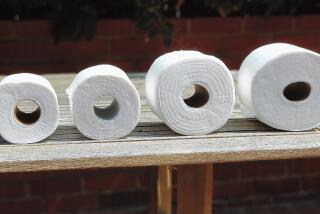Low-Flow Toilets Reduce Costs, Noise
- Share via
QUESTION: Our water bills are too high and I should replace our old stained toilets. How much will installing new low-flow toilets lower my water bills? What types are available and do they flush adequately?
ANSWER: New low-flow toilets not only pay back their cost many times over their life with lower water bills, but they flush quieter and quicker. The styles are more modern, so they complement contemporary bathroom decor.
Toilets are the largest water users in most homes. Low-flow toilet designs use about 1.6 gallons per flush (gpf). Pre-1980 toilets used 5.5 gpf.
For a family of four, switching from a 5.5-gpf to a 1.6-gpf toilet saves about 24,000 gallons of water per year--a 70% savings. Using less water also reduces long-term water and sewage rates and protects the environment.
Two common designs of low-flow toilets are the gravity type and the flushometer tank type. The gravity type works like your standard toilet, but has a special bowl and trap design. This provides adequate flushing with less water. It takes only about 45 seconds to refill after a flush.
Flushometer tanks use a special cylindrical chamber inside of the toilet tank. As the chamber fills with water after a flush, the water pressure compresses the air in it. When you flush the toilet, the compressed air forces the water under pressure to give a forceful positive quick flush.
With a flushometer tank, the bowl is cleared in only 10 seconds, but it takes about 60 to 90 seconds to refill the tank. Flushometer tanks work best if you have normal to high water pressure in your area. Check with a local plumber about your water pressure.
There are also some super-low-flow toilets that use less than 0.5 gpf. One type uses a remote small electric air compressor to assist in the flushing. This produces a very vigorous flush. The small amount of water cleans the bowl and the compressed air quickly forces the wastes past the trap.
Another toilet uses electric elements to incinerate the waste instead of water to flush it away. As the waste is vaporized and burned to a fine white powder, the vapors are vented outdoors. Since it is incinerated at very high temperatures, germs are eliminated and no water is wasted.
When you buy a new toilet, check the specifications carefully. Not all so called “water-saver” toilets will yield the same water savings. The prices for low-flow toilets range from about $100 to more than $300. They are available in most designer colors with various tank and bowl shapes.
You can write to me for Utility Bills Update No. 449 showing a buyer’s guide of 20 manufacturers of low-flow toilets, model numbers, water usage (gpf), design type, prices, product descriptions and diagrams, and a chart showing the water bill savings by installing a new toilet. Please include $1.50 and a self-addressed business-size envelope. Send your requests to James Dulley, c/o Los Angeles Times, 6906 Royalgreen Drive, Cincinnati, Ohio 45244.
Closing Off Registers Won’t Hurt Efficiency
Q: I have heard that you should close off heating and cooling registers in unused rooms to save energy. Will that reduce the efficiency of my furnace or air conditioner by reducing the air flow through it?
A: The heat exchanger and air-conditioning coils in your furnace need adequate air flow for maximum efficiency. Unless you close most of the registers, the total air flow will not change significantly.
You may notice slightly increased noise from the open registers caused by more air being pushed through the fewer open registers. If your ductwork is properly-sized, you probably won’t even notice this small sound difference.

